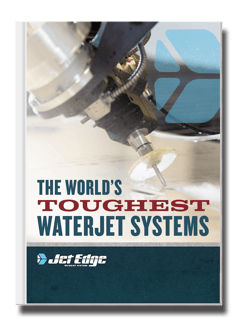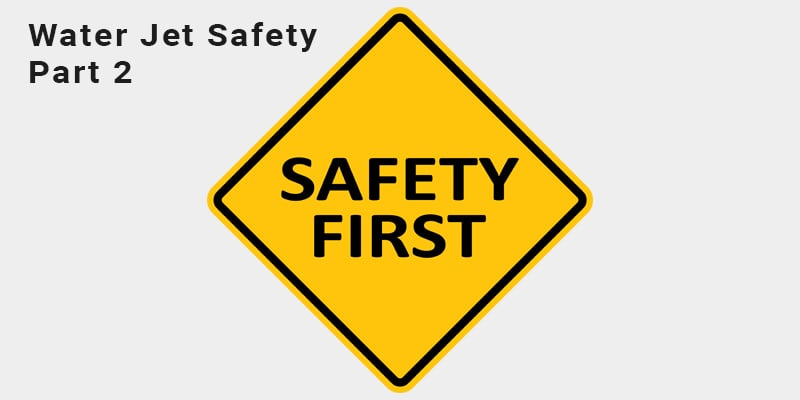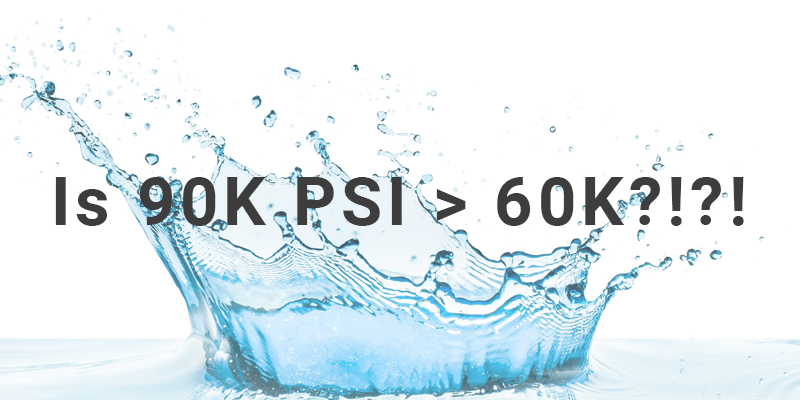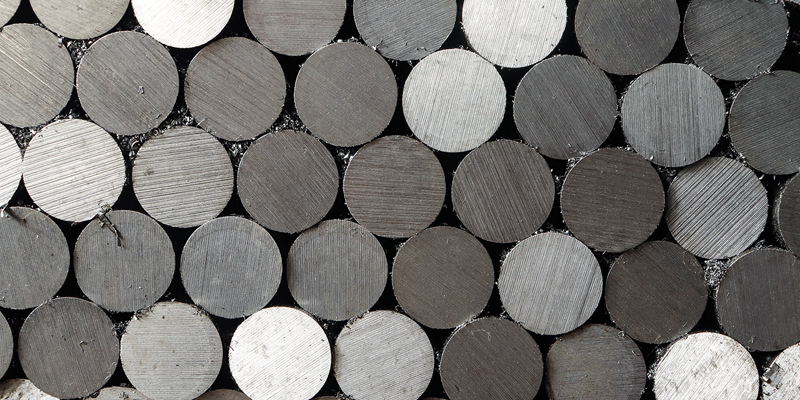If you missed Part 1 of our safety series, click this link Water jet Cutting Safety Part 1: The Motion System for more information on safely operating your water jet’s motion system.
Workplace safety focuses on identifying, preventing, and eliminating hazards that cause accidents or negatively impact worker health. The Occupational Safety and Health Administration (OSHA), part of the United States Department of Labor, sets safety standards that organizations must satisfy. Adhering to these standards is crucial for maintaining a safe working environment.
 Safety First
Safety First
Anyone who operates equipment is responsible for adhering to the safety precautions and operating procedures detailed in the equipment owner’s manual and the company’s safety policies. Proper training ensures operators are proficient in these safety practices. Improper equipment operation and maintenance can create hazardous conditions, resulting in death, injury, and equipment damage. Before using your water jet equipment, ensure you have received comprehensive training and have read and understood your product manuals. Highlight any safety information contained in them.
While there are many financial and reputational benefits to following robust safety protocols and complying with regulations, the best reason is that the safety and wellbeing of your employees should be your number one obligation.
⚠️ Warning: This blog is only intended to provide an overview of safety tips when operating a water jet. Consult your owner’s manual and your company’s safety manual prior to operating or performing service on your water jet system.
Water Jet Cutting Hazards - The High-Pressure Intensifier Pump

A water jet cutting system has numerous components, each with specific safety protocols. This blog focuses on the high-pressure intensifier pump, which generates and delivers the ultra-high-pressure (UHP) water stream to the cutting tool and outlines the best safety practices from setup to ongoing maintenance.
Don’t be fooled by the word “water.” In the context of a water jet, it refers to the output generated by a 60,000 psi (4100 bar) ultra-high-pressure pump, capable of producing water velocities up to 2000 mph (3300 kph). Water jet cutters can easily slice through materials like titanium, stainless steel, and aluminum, which can be several inches thick. Imagine what it can (and will) do to a hand or finger that gets in its path!
Safety Starts with Proper Installation
The high-pressure intensifier pump must be installed by certified technicians familiar with high-voltage electrical equipment, UHP water connections, and pump operation. If you have questions or are uncertain about any process step, contact a supervisor or the pump manufacturer’s support group.
Key installation criteria include:
- Install the pump in a fixed position, isolated from explosive atmospheric hazards like gas, vapor, or dust. For applicable safety standards, refer to the National Electric Code (NEC), OSHA requirements, and local codes.
- Maintain at least 36 inches (90 cm) of clearance around the pump for safe access during routine maintenance or repairs. Additional space may be required to open the electrical enclosure fully.
- Position the pump near electric power and low-pressure water hookups to minimize installation costs.
- Ensure the pump rests on a concrete floor that can support its weight and resist vibration.
- If the pump ships without hydraulic fluid, follow the steps in the owner’s manual to fill the tank before operation. Ensure you use oil that meets the manufacturer’s standards.
- Use high-pressure tubing and fittings rated for the pump’s maximum operating pressure.
After installation, thoroughly test the system to confirm the correct setup and expected performance. Refer to the startup testing procedures in your owner’s manual for detailed instructions.
Pre-Operation Checklist
For maximum safety, all operators must receive comprehensive training before powering up the high-pressure pump. Best safety practices prohibit the pump's operation until all necessary training has been completed successfully or it is under the direct supervision of a competent, trained individual.
Before turning on your intensifier pump, ensure you’ve completed the following steps:
- Review the manufacturer’s product manuals and highlight all applicable safety information for quick and easy reference later.
- Familiarize yourself with the motion system’s operating procedures and ensure you understand all controls.
- Ensure the work area around the equipment is clean, dry, and free of any hazards that may cause trips or falls.
- Ensure any employees or bystanders not involved in operating the equipment are at a safe distance before cutting begins.
- Locate all emergency stops to enable quick shutdown of operations in case of an emergency.
- Confirm you have all the required personal protective equipment (PPE) available and are trained in their proper use.
- Adhere to all safety practices detailed in your company’s safety policy and use common sense to minimize and eliminate operational risks. If something doesn’t look or seem right, get clarification before proceeding.
⚠️Important: If you identify any issue that could create a safety risk, stop operation immediately and consult your safety team before proceeding!
Personal Protective Equipment (PPE)
Wearing proper PPE is non-negotiable when operating a water jet system. The high-pressure stream can create powerful ricochets containing water, abrasive, or debris, while the intensifier pump’s hydraulic system adds risks from heat and high oil pressure.
- Always wear safety glasses or face shields to protect against flying debris.
- Use flame-resistant and water-resistant clothing to safeguard against potential hazards.
- Wear hearing protection, as water jet cutters can generate noise levels above 85 dB, leading to hearing loss with prolonged exposure. Best sound-dampening practices recommend keeping the water level in the catch tank high enough to touch the workpiece. If your water jet has a bladder tank (click here to view our bladder tank blog) that allows for submerged cutting, using this capability significantly reduces noise levels.
- Ensure the use of respiratory protection if airborne particles are present. Proper ventilation is essential to disperse particles, and side shields can help reduce, but not eliminate, particle exposure. Remember, prolonged exposure to airborne particles can cause respiratory health problems.
Safety During Operations
Many intensifier pumps feature advanced configurations including single and dual, redundant systems, and can produce pressures in excess of 60,000 psi. Only trained operators should use the equipment independently; less experienced personnel should operate the water jet only under the direct supervision of qualified and skilled operators.
Check your PPE for proper fit and function and ensure everyone in the area is similarly protected. Do not remove any piece of your PPE while the water jet is operating.
Always Begin Each Shift with a Basic Inspection
- Ensure all cabinet doors are closed and secured during pump operation.
- Activate power to the pump via the power disconnect switch on the side of the electrical enclosure.
- Ensure that the hand valves controlling the flow of UHP water to the tools are open.
- Locate the emergency stop and confirm it is in the operating position.
- After the start screen has loaded onto the touch-screen control panel, confirm the pump settings match those called out in the job packet supplied.
- Ensure no service errors or warnings are present, including prompts to replace hydraulic and water filters. Contact a qualified maintenance person immediately to address any errors or warnings. Never operate the water jet with any warning or error messages displayed!
- Inspect the motion system, intensifier pump, and high-pressure components for water leaks. Remember to use cardboard rather than your hand when inspecting for leaks. If a leak is detected, repair the machine before returning it to service.
- Check the hydraulic fluid level and fluid temperatures on the hydraulic gauge to confirm they are within factory-specified operating ranges.
- Check the intensifier pump for any hydraulic leaks (cardboard is best here, too) and ensure the hydraulic reservoir fluid level is correct.
- Confirm that the hydraulic pressure is at the operating level on the hydraulic pressure gauge.
- Some pump systems will come with a remote start feature. This feature allows the pump to be controlled locally via its touch-screen control panel or remotely from your motion system’s control panel.
- Check that the catch tank is full of water and remove any debris accumulation.
- Verify that the work area around the waterjet is free of obstructions that could cause trips or slips.
- Ensure that nothing obstructs the movement of the waterjet cutting tool or the travel of the UHP whip and swing arms that supply UHP water to the z-axis assembly.
Potential Operational Hazards to Avoid
 When wet, the floor around the catch tank can become slippery, creating a slip-and-fall risk. Clean up any water around the tank and use non-skid rubber mats. Always wear appropriate footwear and remain vigilant of your footing.
When wet, the floor around the catch tank can become slippery, creating a slip-and-fall risk. Clean up any water around the tank and use non-skid rubber mats. Always wear appropriate footwear and remain vigilant of your footing.
 Pressurized fluid streams can easily penetrate the skin, causing severe personal injury. Keep your hands and body away from pinholes and nozzles that eject or are capable of ejecting fluids under high pressure. Use a piece of cardboard, not your hand, when checking for leaks.
Pressurized fluid streams can easily penetrate the skin, causing severe personal injury. Keep your hands and body away from pinholes and nozzles that eject or are capable of ejecting fluids under high pressure. Use a piece of cardboard, not your hand, when checking for leaks.
 High voltage is present! Contact with high voltage, especially in the presence of water, can result in a severe shock (at best) or even death. Keep all covers closed while the water jet and its ancillary equipment operate. Studies show voltages as low as 42 volts and currents as low as 20 mA can have adverse effects and cause death.
High voltage is present! Contact with high voltage, especially in the presence of water, can result in a severe shock (at best) or even death. Keep all covers closed while the water jet and its ancillary equipment operate. Studies show voltages as low as 42 volts and currents as low as 20 mA can have adverse effects and cause death.
 Some machine components will move while the equipment is operating. You must remain aware of component movement so you don’t come into contact with it. Keeping clothing and hands away from the equipment is especially important, and always verify that covers and shields are in place before starting the machine.
Some machine components will move while the equipment is operating. You must remain aware of component movement so you don’t come into contact with it. Keeping clothing and hands away from the equipment is especially important, and always verify that covers and shields are in place before starting the machine.
Routine Maintenance
Intensifier pumps are designed to provide maximum performance with minimum service and repair. However, due to the high pressures, components eventually wear out and must be repaired. Following basic maintenance and inspection procedures can remedy minor problems before significant faults develop.
⚠️ Important: Review the safety section of your owner’s manual before performing any maintenance.
Keep the Pump Clean
Component cleanliness is a primary factor in proper machine performance. Contamination from hydraulic fluid, water, abrasives, etc., can lead to significant equipment failures. Use a damp cloth to remove grit and dirt accumulations on the cross beam, side beams, and z-axis assembly. Frequently rinse the cloth in clean water to avoid recontamination. Ensure thorough cleaning of the equipment after each use.
Keep the Pump Lubricated and Filled with Hydraulic Oil
Use only manufacturer-recommended lubricants and hydraulic oils to ensure compatibility with existing fluids. Follow all the recommendations detailed in the pump’s owner and operation manuals.
Regular Filter Replacement
Filters remove harmful contaminants from the hydraulic oil and water supply. Clogged or obstructed filters can impact cut quality and damage water jet components. To prevent costly repairs, replace hydraulic and water filters per manufacturer guidelines.
Regular Inspections
Before each shift, conduct visual checks of all components, including the cutting head, intensifier pump, valves, and high-pressure lines. Ensure all fittings are tight and there are no visible water or hydraulic oil leaks. Remember, when checking for leaks, use cardboard, not your hand.
Routine Equipment Service
Service procedures should only be performed by individuals experienced in servicing your model of intensifier pump and familiar with all operational aspects of the high-pressure lines, remote pumps, and any installed accessories or options. Always wear appropriate PPE when performing service.
When servicing the high-pressure pump, always follow lock-out and tag-out (LOTO) procedures for the electrical disconnect switch, following OSHA guidelines, to prevent the machine from being turned on during maintenance unless power is required for a maintenance or service procedure. If the service requires power, ensure the waterjet is set to local operation.
⚠️ Warning: Never bypass safety features such as the emergency stop switch. Eliminating safety features can result in personal injury to the operator and financial liability to the company.
⚠️Important: Shutting off the water jet may not remove all pressure. Opening a fitting with residual pressure can produce a cutting, penetrating spray that can result in injury. To reduce high-pressure hazards, verify all pressure is relieved before disconnecting any ultra-high-pressure water line by bleeding off residual pressure and confirming all pressure gauges read zero before starting service. Ensure all connections are adequately tightened after performing service or maintenance.
Equipment Repairs
Never modify your equipment without consulting the original equipment manufacturer (OEM). Modifications may void warranties, cause unpredictable equipment behavior, and result in personal injury or death, exposing the company to liability. If assistance is needed to diagnose an issue or resolve any uncertainty about performing a repair, contact your OEM's service department before starting any service (click here to visit Jet Edge's service department).
Safety is Not a One-Time Exercise
Adherence to safety protocols is essential for maintaining a safe working environment. If you do not have a copy of your water jet systems’ operating manual including outlining the safety protocol and operating procedures, please request one immediately from your OEM. If you’re using a Jet Edge system, please request one from our technical support page.
If you need assistance, contact our Technical Service Team. They’re available 24/7/365 to help you keep your water jet system operating safely and efficiently.
JetSmart Digital Displays and Control
Since you cannot directly observe the intensifier pump during operation, HERO intensifier pumps are available with the innovative JetSmart touchscreen controls feature for real-time monitoring and to ensure safe operation. The Run Screen display simplifies settings and presents real-time status information in a clear and concise manner. For example, operators can easily view critical performance metrics, including pressure consistency, setup errors, and seal conditions. The system displays important service reminders based on operating hours or cycles to help maintain equipment reliability.

Maintenance Support and Training
Jet Edge provides 24/7/365 live telephone support and is there for you if you need help and free factory training for those operating Jet Edge equipment. Additionally, a library of routine maintenance training videos is available so you can take advantage of real time training at your convenience.
Click on the image below to view our full library:
Visit our Blog Library and Comprehensive Video Collection
Jet Edge offers a comprehensive library of maintenance training videos, case studies, best practice blogs and a whole lot more in our resource center.
If you would like to learn more about Jet Edge Water jet Systems, visit us online at jetedgewaterjets.com. If you are ready to speak with your regional expert, just let us know on our contact us page, or call us toll-free at 1-800-JET-EDGE (538-3343), internationally at +1-763-497-8700.
Check out our Water Jet Cutting Safety Part 1: The Motion System blog for more information on safely operating your water jet’s motion system.

Check Out Our Digital Brochure!
Since 1984, Jet Edge has been designing and manufacturing Ultra-High-Pressure Water jet technology that doesn't back down. Our systems are used around the world in a broad range of industries from the world's leading airlines, to automotive, aerospace and industrial manufacturers, and machine job shops.
To learn more about the Jet Edge difference, our water jet motion systems, pumps and much more, click the button "Download Brochure" to get it now!








%20-%20Jet%20Edge%20Waterjets.png)



